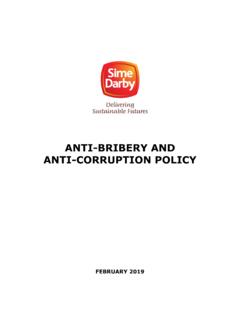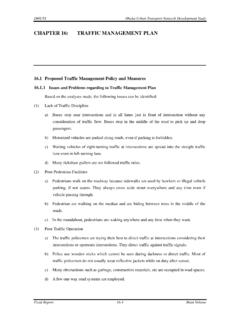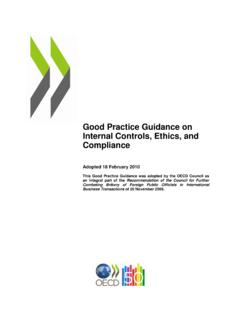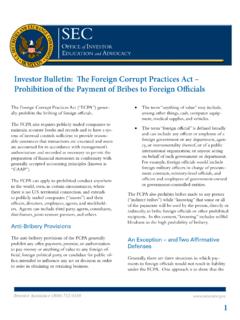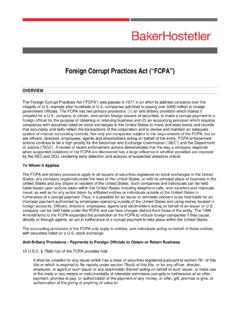Transcription of NGO Risk Management - Humanitarian Outcomes
1 NGO Risk ManagementPrinciples and Promising PracticeWith heightened levels of violence in some conflict settings, coupled with proliferating legal and fiduciary regulations related to anti-corruption and counter-terror efforts, Humanitarian non-governmental organizations (NGOs) are contending with new and intensified risks to their personnel, operations, and organizations. Some of the larger international NGOs have begun to adopt organization-wide risk Management frameworks to better enable effective programming in high-risk situations. This handbook is meant to serve as a primer and quick reference tool for Humanitarian organizations on the basic principles of risk Management .
2 It presents concrete examples of promising practices as well as pitfalls to avoid. The handbook draws upon the findings of a 2016 study, NGOs and Risk, conducted by Humanitarian Outcomes for InterAction, with the participation of 14 major international NGOs. The full report, as well as a sample risk register template and a list of key resources, can be found here: independent organisation providing research evidence and policy advice to inform better Humanitarian action2 Key TermsThreat: A danger or potential source of harm or lossRisk: The likelihood and potential impact of encountering a threatRisk Management : A formalized system for forecasting, weighing, and preparing for possible risks in order to minimize their impactTypes of riskOrganizations have their own ways of categorizing and grouping types of risk.
3 Below is the generic categorization used for the NGOs and Risk study, with area Definition ExamplesSecurity Violence or crime Kidnapping of staff Armed attack on facilities Collateral damage from airstrikeSafety Accident or illness Road accidents Fire in office or residenceFiduciary Resources not used as intended Diversion of aid materials (fraud/theft/ bribery ) bribery of local officials Misallocation of earmarked donationsInformation Data loss, breach, or misuse Theft of donor credit card information Breach of personnel data or other sensitive information Inappropriate communications by staff on social mediaLegal/compliance Violation of laws/regulations Violations of host-country labor codes or other laws Violations of international sanctions or counter-terror restrictions Reputational Action, information or Negative media stories perceptions damaging to Negative public statements or litigation by staff.
4 Integrity or credibility ex-staff or stakeholdersOperational Inability to achieve Human error objectives Capacity deficits Financial deficitsThe risk Management approachOrganizational risk Management frameworks seek to integrate all major areas of risk within a unified conceptual and planning platform. Sometimes referred to as enterprise risk Management or ERM, this approach has its roots in the private sector and has only recently been taken up by aid most well developed risk Management frameworks include: a risk register tool for analyzing and prioritizing risks and planning mitigation measures; decision-making and implementation procedures flowing directly from that assessmentand planning; a systematic follow-up or audit process to ensure good implementation and understanding; and, toincorporate learning.
5 And a means for weighing criticality, or the degree to which the action is urgent or life-saving, in order toguide decision-making on acceptable levels of risk (sometimes called program criticality ).Risk Management : Definitions and basic principles3 The risk register: A tool to assess, prioritize and mitigate organization-wide risksA sample risk-register matrix template, compiled from examples used by the participating NGOs, can be downloaded here: risk register is a way to build a comprehensive picture of the most serious risks facing an organization at any given time. It should be built from the ground up, with each country office and each functional area of the organization ( , program, legal, communications) conducting an exercise to identify and rank the risks they face in all categories.
6 These in turn inform the organization-wide risk register, which is compiled at the central level at least once per the same logic as for a security risk assessment, completing a risk register involves ranking risks in all categories by their perceived degree of likelihood as well as the level of impact they would have on the organization if realized. Once the risks are identified and prioritized, the process involves developing strategies to mitigate them, including outlining ways that procedures and practices may need to be adjusted. The risk register also provides a valuable tool for benchmarking progress against these plans throughout the year, including through risk audits or other follow-up promising practices related to risk Management identified in the report include: Catalogue missteps and realized risks : The senior Management of one INGO compiled a list of all significant mistakes or bad Outcomes that affected the organization over the year, (and ways they may have been avoided or mitigated) and shared it with the entire organization as a learning tool.
7 Because many staff members tended to be only vaguely aware or misinformed of such incidents, this new practice helped foster openness and lesson-learning. Adapt to work with high-risk partners: Specific steps can be taken when working with high-risk national-partner NGOs, such as those that lack the capacity to meet donor requirements or don t have financial reserves. INGO staff can be seconded to sit within a partner organization; funds can be disbursed in smaller amounts or more frequently; and additional funds can be obtained for mentoring and capacity building. INGOs should also assess their motivations for partnering and their capacity to partner before initiating the partnership.
8 Prepare for host-country legal challenges: Tax, registration, and other legal compliance issues take time and energy and are so country-specific that they are difficult for a globally operating organization to resolve and foresee. Some INGOs have found that retaining national lawyers can avoid legal missteps, deal quickly with situations that arise, and provide input into relevant policies, , country-specific HR policies. Hire external experts to conduct IT security audits: Many INGOs are under-informed about the increase in information risks , which include hacking into fundraising systems (to steal donors credit card or other sensitive information) and defrauding national-staff administration software.
9 External professionals can conduct IT security audits to identify technological and procedural problems and fix vulnerabilities. Ensure that brief and user-friendly tools are available in the field: Basic, digestible tools get used. For example, sample risk-register templates can be posted in field offices. Focus and insist on tools and trainings that are practically-oriented. Review and improve national-staff security: One INGO made the unprecedented decision to evacuate national-staff members and their families when a province was overrun by anti-government forces and they were deemed to be at direct risk.
10 The ad hoc decision revealed the need for, and helped to spark, policy development on this issue. Generally, many INGOs could take steps to mitigate national-staff security risks , including improving off-hours transportation, communications, and site security at home. Admit and disclose fraud: Several INGOs have taken a decision to proactively disclose incidents of fraud or financial mismanagement. This can demonstrate openness and good Management , which institutional as well as private donors can appreciate. Promising (and poor) practices in risk management5 Poor practices Miscalculating risks by focusing on likelihood over potential impact: An INGO working in Turkey providing cross-border aid to Syria was storing Humanitarian goods inside Syria instead of Turkey, in order to comply with Turkish customs regulations.
